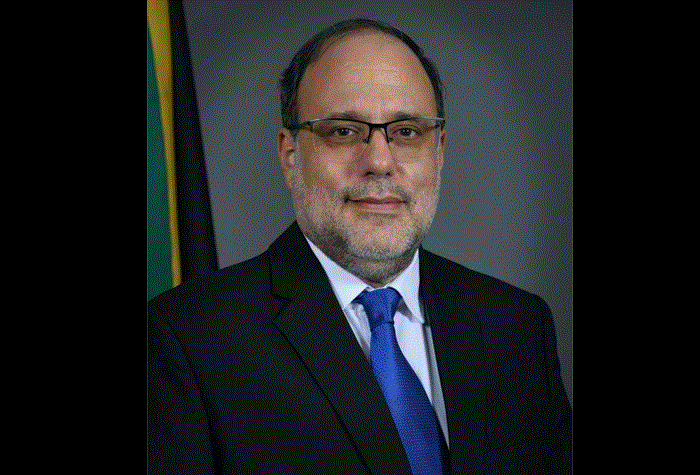BY Audley Shaw, Guest Columnist, Jamaica Observer
IN a speech and an article published recently, both former Prime Minister PJ Patterson and former Finance Minister Dr Omar Davies are seeking to rewrite the history of the Jamaican economy.
So, for the young, for students of history and for everyone, I wish to tell the other side of the story, and in doing so I will use hard, incontrovertible facts, not conjecture, half-truths, convenient ignorance or fiction. And I will be bold enough to say that if anyone wishes to challenge the accuracy of my assertions, I will be willing to debate them in a public square at any time and any place.
SHAW… let us not rewrite history by ignoring what we find too uncomfortable and inconvenient to confront
1/1
Truth is the only fixity, and we must come face-to-face with it and call a spade a spade as this is the only way we will learn from our past errors, policy failings and incidents of downright fiscal imprudence and irresponsibility.
The Background
Next year, as we celebrate our 50th anniversary of Independence, let us examine how we have fared since 1962. The truth is that we have been slipping and sliding, taking two steps forward and one step, sometimes even two steps backward. We have failed to be consistent and predictable in economic management from one political administration to the next, leading to limited progress, a loss of confidence and even cynicism within our investment and entrepreneurial community.
The Halcyon Days Of The 1960s
Today, as Dr Davies brazenly brags about three per cent growth in one or two years of his stewardship as finance minister, he ignores the fact that during his entire 14 years, the average GDP growth was barely over one per cent per year (1.2 per cent). Contrast this with the JLP Government from 1962 to 1972 which achieved average annual GDP growth of six per cent, with record growth in 1965 of 10 per cent and a whopping 11.9 per cent in 1970.
It is not without irony that despite this period of record growth, the Government was changed in 1972 on the PNP’s promise of “Better must come”.
The 1972-1980 Period Of Unprecedented Economic Decline
Despite economic growth in 1972 and 1973 which were ‘momentum years’ bequeathed by the JLP, the period 1972 – 1980 was characterised by economic mismanagement and ideological polarisation, where the policy of democratic socialism was formally announced and the PNP declared their intention to take control of “the commanding heights of the economy”.
People were invited to take five flights a day to Miami. And they did. Over 20,000 professionals left Jamaica, including my brother and other family members.
It is widely acknowledged that although the oil crisis of the 1970s contributed to Jamaica’s economic challenges, the primary reason that the economy fell into persistent decline was due to a diversion from the management of our economy along the fundamental lines of a market economy.
Mr Manley’s pronouncement that he would “walk to the mountaintop with Comrade Fidel” was instructive.
The growth figures tell a clear story of this dangerous period of mismanagement in which the concept of negative growth was introduced for the first time since independence. After the ‘momentum year’ of 1972 which saw the new Administration inherit GDP growth of 9.1 per cent, all but two years during the period recorded negative growth: 1974: -3.9 per cent, 1975: -0.3 per cent, 1976: -6.5 per cent, 1977: -2.4 per cent, 1979: -1.8 per cent and 1980: -5.7 per cent. The two years in which marginal growth was achieved were: 1973: 1.3 per cent and 1978: 0.6 per cent.
Despite the institution of important social legislation, the economy fell into a sharp decline which eventually led the people of Jamaica to reject attempts by the PNP to introduce an alien political philosophy to a traditionally free market/capitalist-oriented society.
The Rebuilding of the 1980s
The JLP, led by Edward Seaga, was swept to victory in 1980 on a pro-capitalist, market-friendly and management-oriented platform.
Despite being faced with the devastation of the 1970s, including six years of negative growth and a fallout in bauxite/alumina earnings in the early 1980s, the JLP Administration successfully restructured the economy and restored the productive base of the country.
The Jamaica National Investment Promotion Limited (JNIP) was established to promote investment. Over the period, new industries were established, productivity increased, and the country started exporting products to the world again, with non-traditional agricultural goods and the apparel sector being notable contributors. Importantly, after years of wallowing in the doldrums, the tourist industry was revived through the famous “Come back to Jamaica” marketing programme.
By 1986, the economy began to grow again, and between 1986 and 1990 it grew by an annual average of over 5.0 per cent. It is of some note that the only two periods in which Jamaica has experienced annual high growth rates occurred under the JLP administrations of the 1960s and the 1980s. The growth momentum created during those periods produced a spillover effect during the first two years of the PNP administrations of the 1970s and the 1990s.
It is also of note that notwithstanding the negative growth rate it inherited, the JLP Administration of the 1980s grew the economy in every year of the period except in 1984 and 1985.
In 1987, the economy grew by 8.0 per cent, and even during 1988 — the year of Hurricane Gilbert — the economy still grew by 2.2 per cent. In addition to economic growth, 30,000 net new jobs were created between 1986 and 1988, with the economy recording a fiscal surplus in 1989.
1990s to 2007 – The Financial Sector Collapse And The Crushing Of The Entrepreneurial Spirit
It is this period that both the former prime minister and the former minister of finance seek to forget. They blatantly ignore the underlying issues that led to the collapse of the financial sector and its catastrophic effects on both the economy and the psyche of our people. Curiously, the former PM states that if Finsac had not been established “there would’ve been a bloodbath that would’ve made the Morant Bay Rebellion look like a Sunday school picnic” — entirely side-stepping responsibility for having set into motion the dynamics which necessitated Finsac’s establishment.
Equally curious is Dr Davies indulging in self-praise for having saved the bank accounts of small savers, pensioners and poor people, while assigning wholesale blame to the management of over 40 financial institutions which collapsed during the period. More than 10 years on, Dr Davies stubbornly refuses to acknowledge what we all recognise: that it was his own ruinous polices which were the root cause of a systemic meltdown of the financial sector.
Critical Analysis Needed
It is precisely this kind of selective treatment of history that occasioned the need for a Commission of Inquiry into the causes of the financial sector collapse of the 1990s.
In a long statement to the Commission of Inquiry, the former finance minister blamed everybody but himself and rubbished claims that his Government’s protracted high interest rate policy led to the collapse of the sector.
Although the financial sector collapses experienced in different countries have varying underlying causes, Dr Davies erroneously claims that Jamaica’s meltdown was unconnected to his high interest rate policy, and takes solace in the fact that some countries which suffered collapse did not have high interest rates.
Amazingly, he wants us to ignore the fact that for the decade of the 1990s under the stewardship of four finance ministers — Seymour Mullings, PJ Patterson, Hugh Small and Omar Davies — commercial bank lending rates averaged 53.0 per cent per annum, and BOJ rates, at one time, were in excess of 50 per cent. He also conveniently fails to recall that prime commercial bank lending rates climbed to a high of 80 per cent, with interest penalties on overdrafts reaching a high of 120 per cent.
Some Of The Causes Of The Collapse
In 1989, outgoing Prime Minister and Finance Minister Edward Seaga urged the new PNP Government to manage the emerging growth in the economy with care, as it was important to keep macroeconomic variables carefully in balance.
Mr Seaga also warned then PM Michael Manley not to liberalise the foreign exchange market prematurely. It was critical, he warned, that enough foreign exchange reserves be left in place to withstand pressure on the exchange rate from excess demand for US dollars.
His warnings were not heeded. The foreign exchange market was liberalised, money supply targets were constantly exceeded, causing liquidity in the market to drive speculation and demand in the foreign exchange market. Before long, the most vulgar situation arose: the Bank of Jamaica began to compete on the streets for the purchase of foreign exchange, sending out agents with raw cash in their car trunks.
The Government of the day jacked up interest rates in a frantic attempt to “mop up liquidity”. At the same time, the rate of inflation sky-rocketed, peaking at over 100 per cent, while the exchange rate went into free fall, moving from J$5.50/US$1.00 in 1989 to over J$70/US$1.00 by 2007 — a staggering 92.1 per cent depreciation.
What followed was a tsunami of business failures. This was inevitable as business people were no longer able to service their debts, and with loan demand falling, some commercial banks started diverting investments to the real estate, agriculture and tourism sectors.
Eventually, over 40 financial institutions were closed and over 40,000 businesses failed, adversely affecting the lives of hundreds of thousands of people. It resulted in broken homes, broken families, migration, devastation, dislocation, people dying with broken hearts and some even committing suicide.
This led to the establishment in 1996 of the Financial Sector Adjustment Company (Finsac), a resolution company acting on behalf of the Government of Jamaica.
Any discerning reader can see the major gaps and omissions in the disingenuous arguments of the former prime minister and the former minister of finance.
To suggest that Finsac was established because there was corruption and mismanagement in the banks is dishonest in the extreme. Does this mean that the 40,000 people who lost their businesses were also dishonest and corrupt people?
The former finance minister’s unseemly strategy is to seek to silence his detractors by using their failure in business against them without acknowledging his own role in causing those failures. In Parliament, he has repeatedly accused Pearnel Charles of once crawling on his knees, begging him to save his bank — a cruel and unworthy act for a former minister of finance. Dr Davies also continues to issue libellous statements suggesting that I had failed to honour agreements with Finsac. This has been refuted by me in several published statements since 2008 in which I have stated that, while I had no agreement with Finsac, I paid money to Finsac and subsequently settled with JRF to whom my account was sold. If he repeats this falsehood, I intend to take appropriate legal action against him.
The truth is that I am a wearer of that dubious badge of honour: “Finsac Debtor” — a badge shared by over 40,000 victims whose businesses were annihilated during what is now acknowledged as the most ruinous period of Jamaica’s economic history.
The most unfortunate aspect of the financial sector meltdown of the 1990s is the psychological damage that still afflicts Jamaican business people who are severely risk-averse.
Worse yet, the residual effects of the 1990s may be seen in young people who, in the normal course of events, ought to have been attracted to pursuing a life in business. Indeed, one of the most challenging things that faces me in my mission to motivate the country to “grow our way out of debt”, is to find strategies to encourage people to overcome the psychological scars of the 1990s.
This challenge is made more difficult by the fact that many Finsac debtors still struggle with servicing payments today. In so doing, they continue to bear witness to others of that damaging bygone period. Is it any wonder, therefore, that Finsac’s total cost might never be accurately calculated?
Impact On Growth
The most telling negative impact on Jamaica’s economy may be summarised in the horrific average growth rate during Dr Davies’s 14-year tenure. Under his watch, Jamaica’s growth averaged 1.2 per cent while the world economy grew at 5.0 per cent per year and growth in the Caribbean and Latin America exceeded 6.0 per cent.
The simple, unvarnished truth about our record of economic growth since Independence is that JLP governments have consistently set the stage for sustained economic growth, only to see those gains ravaged by the mismanagement of the PNP. It is a fact that on the two occasions since Independence that the JLP handed over the economy to the PNP, it was handed over in a state of vibrant health.
Between 1969 and 1971, the economy grew by 20.3 per cent, and grew by another 9.1 per cent in 1972 — the year Government was transferred to the PNP. Many young people today will have difficulty imagining Jamaica recording cumulative growth of 29.4 per cent over a four-year period! I am determined to return the economy to a similar state of vibrancy.
Equally, after the economic decline of the 1970s, the JLP Government of the 1980s rebuilt the economy back to good health. Between 1986 and 1988 the economy grew by 12 per cent, peaking at a growth rate of 8.0 per cent in 1987. In 1989 — the year of transfer to the PNP — Jamaica’s economy grew by seven per cent, followed by 6.3 per cent in 1990. Sadly, we have since lapsed into average growth rates of one per cent and under per year. These are the incontrovertible facts, as shown in the table below.
We must come to terms with the fact that numbers do not lie. This sharp contrast since Independence shows a direct correlation between the quality of economic management and GDP growth.
Everyone should carefully study the story of economic growth and decline shown in the following line graph and, thereafter, regard the next election as a referendum on economic management.
The key question to be asked is whether Jamaica can afford to continue this cycle of rebuilding, only to see the gains made summarily destroyed by irresponsible governance.
Conclusion
Notwithstanding the worst global economic crisis in over 80 years, and notwithstanding the economic mess that we have inherited, this Administration has been able to achieve, in just 3 1/2 years, the kind of macroeconomic stability that Jamaica has not experienced in a long time. Let us acknowledge the following remarkable achievements which are all occurring at the same time:
* Stable exchange rate
* No capital flight
* Record net and gross foreign exchange reserves
* Record low BOJ/GOJ interest rates, especially to the real sector
* Single-digit inflation
* Rising employment
* Deficit target which is being met
* Improvement in our balance of payments
* Growth has once again begun, with 1.5 per cent recorded in the March quarter
* Comprehensive Tax Reform underway
This, my fellow Jamaicans, is but a part of “the other side of the truth”. Let us not rewrite history by ignoring what we find too uncomfortable and inconvenient to confront. We owe it to future generations to face the truth and to challenge ourselves to absorb the lessons it offers.
Let us not commit the errors of the past by even thinking of re-electing a party with such a dismal record of economic mismanagement as that held by the PNP. Coming out of the dual crises of PNP mismanagement and the global economic meltdown requires a sustained period of sound management of which this Administration is demonstrably capable.
It is my fervent hope that you will be inspired to join forces with us as, together, we write a more productive and uplifting chapter in Jamaica’s life. We all deserve it.
Audley Shaw is the Minister of Finance & the Public Service.
SOURCE: http://www.jamaicaobserver.com/columns/The-other-side-of-the-truth_8950793
Author Profile
- ... author, qualified & experienced in journalism, creative writing, editing, the arts, art critique, paralegal, photography, teaching, research, event planning, motivational speaking, workshops for children and adults, visual arts etc. Click here for contact form. ...or email me here
Latest entries
 Raw and DirectDecember 28, 2025Jamaican street foods everybody loves
Raw and DirectDecember 28, 2025Jamaican street foods everybody loves AdvertorialDecember 27, 2025Legal Wiz Jamaica
AdvertorialDecember 27, 2025Legal Wiz Jamaica General categoryDecember 27, 2025Jamaica postal codes across island
General categoryDecember 27, 2025Jamaica postal codes across island Raw and DirectDecember 25, 20252025 Christmas message with Anthea McGibbon
Raw and DirectDecember 25, 20252025 Christmas message with Anthea McGibbon





